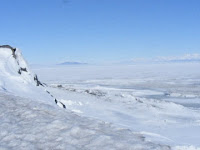




13 Jan
Monday, 13 January was spent really turning the Hab into a work area. We installed internal hardware including lights, heaters, cameras, computers, and air quality monitors (Humidity, airflow, & CO2 sensors). We also started the installation of instrumentation (loop antennas and saw tag antennas) and established communications with the various temperature and pressure sensors. The weather station has been activated and connected to the habitat computer and most of the sensors have started monitoring and recording data. Communication with the McMurdo Intranet was also established and verified.
Another key activity was using a thermal imaging camera to take readings not only of the inflatable hab, but also operational Jamesway huts at the Long Duration Balloon Facility at Williams’s field. The Jamesway is a 1950’s era plywood/canvas unit that has been used by NSF for a number of years and is comparable in size and functionality to our unit. This thermal imaging will help us understand what heat leak we experience with our unit, and we expect a significant improvement on thermal efficiency.
Plans for tomorrow call for completing additional sensor installation and calibration, CO2 monitoring of the interior while in use, and a “christening” of the Hab with the six of us overnighting in it Wednesday night.
This blog entry is actually being entered while in the Hab itself, so we have officially established a “home away from home” !!!!!!!



















































